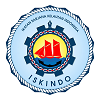IDENTIFIKASI IKAN SARDIN KOMERSIAL (Dussumieria elopsoides) YANG DIDARATKAN DI PASAR MUARA ANGKE, JAKARTA MENGGUNAKAN PENGAMATAN MORFOLOGI, MORFOMETRIK DAN DNA BARCODING
Abstract
ABSTRACT
Sardines are an important commodity in import activities. Excessive imports and lack of catch data are feared to reduce fish stocks. To complete the fish catch data required knowledge of body type and size. This study aims to identify and confirm commercial sardines species landed at Muara Angke Market, Jakarta using morphological, morphometric, and DNA barcoding methods targeting the Mitochondrial Cytochrome c oxidase-I (COI) gene. The results of morphological and morphometric analysis showed that the samples are the genus Dussumieria originating from the Dussumieriidae family, the Order Clupeidae, having silver-colored body characteristics with reflections resembling rainbows, slender bodies and rounded stomachs with a maximum length of up to 14.4 cm, then less abdominal fins advance from the midsection. Based on the relationship of body weight length, this fish is negative allometric. Molecular DNA barcoding analysis using COI, obtained by type of Dussumieria elopsoides fish with local name of rainbow sardines, similarity level with Query Cover percentage was 94% and Per percentage. Ident of 91.64%. DNA barcoding analysis has corroborated morphological and morphometric observations by obtaining fish samples identified as Dussumieria elopsoides.
Keywords: Morphology, Morphometrics, DNA Barcoding, Dussumiera elopsoides.
ABSTRAK
Ikan sardin merupakan komoditas penting dalam kegiatan impor. Impor berlebih serta kurangnya data penangkapan dikhawatirkan dapat menurunkan stok ikan. Untuk melengkapi data tangkapan ikan diperlukan pengetahuan mengenai jenis dan ukuran tubuhnya. Penelitian ini bertujuan untuk mengidentifikasi dan memastikan jenis ikan sardin komersial yang didaratkan di Pasar Muara Angke, Jakarta dengan menggunakan studi morfologi, morfometrik, dan metode DNA barcoding dengan target gen Mitokondrial Cytochrome c oxidase-I (COI). Hasil analisa morfologi dan morfometrik menunjukkan bahwa sampel merupakan genus Dussumieria berasal dari famili Dussumieriidae, Ordo Clupeidae, memiliki karakteristik tubuh yang berwarna silver dengan pantulan menyerupai pelangi, tubuh ramping dan perut membulat dengan panjang maksimal dapat mencapai 14,4 cm, kemudian sirip bagian perut kurang maju dari bagian tengah tubuhnya. Berdasarkan hubungan panjang berat badan, ikan ini bersifat alometrik negatif. Analisis DNA barcoding secara molekuler menggunakan COI, didapatkan ikan berjenis Dussumieria elopsoides dengan nama lokal ikan sardin pelangi, tingkat kemiripan dengan presentase Query Cover sebesar 94% dan presentase Per. Ident sebesar 91,64%. Analisis DNA Barcoding telah menguatkan pengamatan morfologi dan morfometrik dengan didapatkan sampel ikan yang teridentifikasi berjenis Dussumieria elopsoides.
Kata Kunci: Morfologi, Morfometrik, DNA Barcoding, Dussumiera elopsoides.
Full Text:
PDF (Bahasa Indonesia)References
DAFTAR PUSTAKA
Akbar, N. N., & Labenua, R. (2018). Keragaman genetik Ikan Cakalang (Katsuwonus pelamis) di Perairan Laut Maluku Utara. DEPIK Jurnal Ilmu-Ilmu Perairan, Pesisir dan Perikanan, 7(2), 164-176.
Abdullah, A., & Rehbein, H. (2016). DNA Barcoding for The Species Identification of Commercially Important Fishery Products in Indonesian Markets. International Journal of Food Science and Technology.
Amorim, A., Fernandes, T., & Taveira, N. (2019). Mitochondrial DNA in human identification: a review. PeerJ, 7, e7314.
Bukit, S. T. A. K., Affandi, R., Simanjuntak, C. P., Rahardjo, M. F., Zahid, A., Asriansyah, A., & Aditriawan, R. M. (2017). Makanan ikan famili Clupeidae di Teluk Pabean, Indramayu. In: Hadie W, Hadiaty RK, Lusiastuti AM, Syafei LS, Hadie LE, Simanjuntak CPH, Haryono, Rahardjo MF, Affandi R (Editors). Dalam: Prosiding Simposium Nasional Ikan dan Perikanan. Masyarakat Iktiologi Indonesia, Bogor, 12-13.
Hebert, P. D., Cywinska, A., Ball, S. L., & Dewaard, J. R. (2003). Biological identifications through DNA barcodes. Proceedings of the Royal Society of London. Series B: Biological Sciences, 270(1512), 313-321.
Jefri, E., Zamani, N. P., Subhan, B., & Madduppa, H. H. (2015). Molecular phylogeny inferred from mitochondrial DNA of the grouper Epinephelus spp. in Indonesia collected from local fish market. Biodiversitas Journal of Biological Diversity, 16(2)., 254-263.
Keskİn, E., & Atar, H. H. (2013). DNA barcoding commercially important fish species of T urkey. Molecular ecology resources, 13(5), 788-797.
Ko, H. L., Wang, Y. T., Chiu, T. S., Lee, M. A., Leu, M. Y., Chang, K. Z., ... & Shao, K. T. (2013). Evaluating the accuracy of morphological identification of larval fishes by applying DNA barcoding. PLoS One, 8(1), e53451.
Kripa, V., Mohamed, K. S., Koya, K. P., Jeyabaskaran, R., Prema, D., Padua, S., ... & Dhanya, A. M. (2018). Overfishing and climate drives changes in biology and recruitment of the indian oil sardine sardinella longiceps in Southeastern Arabian Sea. Frontiers in Marine Science, 5, 443, 1-20
Maulid, D. Y., Nurilmala, M., Nurjanah, N., & Maddupa, H. (2016). Molecular Characteristics of Cytochrome B for Mackerel Barcoding. Jurnal Pengolahan Hasil Perikanan Indonesia, 19(1), 9-16.
Myers, P., R. Espinosa et al., (2013). http:// animal diversity. ummz. umich. Edu /collections/contributors/Grzimek_fish/Clupeiformes/Chirocentrus_dorab/. [accessed date : 06 Desember 2019
Nair, P. N. (1982). On the systematics of rainbow sardines Dussumieria spp.(Family: Dussumieriidae, Pisces) from Indian waters. Journal of the Marine Biological Association of India, 24(1&2), 80-91.
Nurilmala, M., Widyastuti, U., Kusuma, W. A., Nurjanaha, N., Wulansari, N., & Widyatuti, Y. (2016). DNA barcoding for identification of processed tuna fish in Indonesian market. Jurnal Teknologi, 78(4-2), 115–118.
Pauly, D. (2010). Gasping fish and panting squids: oxygen, temperature and the growth of water-breathing animals. In: Excellence in Ecology. Book 22. O. Kinne (Ed.). International Ecology Institute, Oldendorf/Luhe, 216 p
Santos, M. N., Gaspar, M. B., Vasconcelos, P., & Monteiro, C. C. (2002). Weight–length relationships for 50 selected fish species of the Algarve coast (southern Portugal). Fisheries research, 59(1-2), 289-295.
Sekretaris Jenderal Kementerian Kelautan Perikanan Republik Indonesia. (2018). Buku Laporan Tahunan 2017 Kementerian Kelautan dan Perikanan Republik Indonesia.
Sembiring, A., Pertiwi, N. P. D., Mahardini, A., Wulandari, R., Kurniasih, E. M., Kuncoro, A. W., ... & Carpenter, K. E. (2015). DNA barcoding reveals targeted fisheries for endangered sharks in Indonesia. Fisheries Research, 164, 130-134.
Strauss, R. E., & Bond, C. E. (1990). Taxonomic methods: Morphology in Methods for Fish Biology: C. B. Shreck & P. B Moyle (Eds). Am. Fish. Soc. Bethesda, Maryland. USA.
Triandiza, T., & Madduppa, H. (2018). Aplikasi Analisa Morfologi dan DNA Barcoding Pada Penentuan Jenis Kepiting Porcelain (Pisidia sp.) Yang Berasal dari Pulau Tunda, Banten. Jurnal Sumberdaya Akuatik Indopasifik, 2(2).
Ward, R. D., Zemlak, T. S., Innes, B. H., Last, P. R., & Hebert, P. D. (2005). DNA barcoding Australia's fish species. Philosophical Transactions of the Royal Society B: Biological Sciences, 360(1462), 1847-1857.
Whitehead, P. J. P. (1985). FAO species catalogue, Vol. 7. Clupeoid fishes of the world. An annotated and illustrated catalogue of the herrings, sardines, pilchards, sprats, anchovies and wolf herrings. Part 1-Chirocentridae, Clupeidae and Pristigasteridae. FAO Fish. Synop., 125, 303.
DOI: https://doi.org/10.21107/jk.v13i2.6397
Refbacks
- There are currently no refbacks.

This work is licensed under a Creative Commons Attribution 4.0 International License.

Jurnal Kelautan by Program Studi Ilmu Kelautan is licensed under a Creative Commons Attribution 4.0 International License.
Published by: Department of Marine Sciences, Trunojoyo University of Madura













